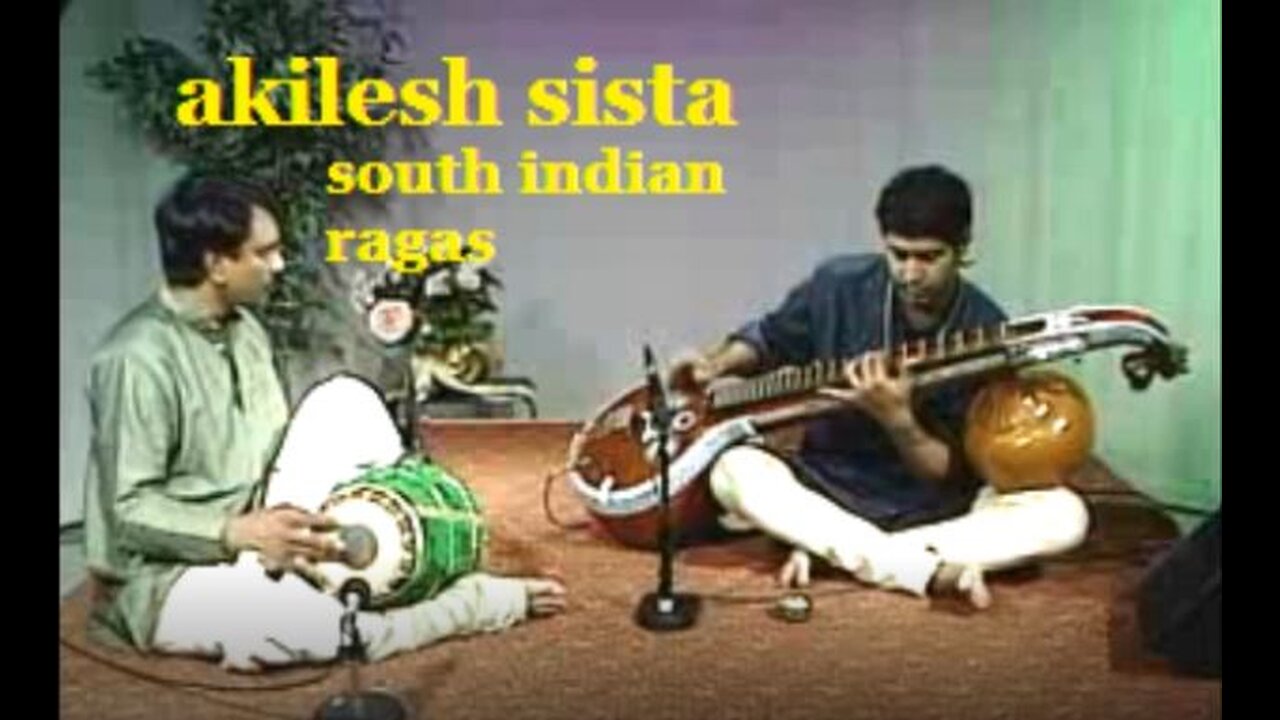Premium Only Content

AKILESH SISTA---SOUTH INDIAN RAGAS
The Veena is one of the most ancient South Indian instruments. Although its exact origin is not known, it has been referred to in the old Vedic texts (1550-500 BC). The ancient veenas resembled lutes and had similarities to instruments used in ancient Egyptian and Middle Eastern civilizations.
The present day Saraswathi Veena (dating back to the early 17th century) is a stringed musical instrument with a hemispherical resonating enclosure (kudam) at one end, and a gourd-shaped support (surakkai) at the other.
A fret board (danda) connects these, with twenty-four brass frets set in wax. The frets are set to half-steps in two octaves. Four main strings traverse this fret-board, from a bridge at the right end to tuning pegs (biridais) at the left end. At this left end of the danda is attached a yazhi, which is a scroll that is carved into an elaborate dragon head.
Three additional strings (talam strings) are set off to the side and are used for rhythmic emphasis. The Veena is one of the few self-contained musical instruments that has both melodic (the fret-board) and rhythmic aspects (talam strings). It shows a remarkable ability to reproduce the intricacies of the human voice in all its subtleties.
The veena player sits cross-legged on the floor and plays the instrument horizontally. The surakkai rests on the vainika's left thigh. The right hand is used to pluck the strings with picks and the left hand slides over the fret-board laterally and transversely to create the microtones characteristic of Carnatic music. The little finger of the right hand also strums the talam strings.
The wood for the Veena comes from the jack-fruit tree. The art of building a good Veena is a trade-secret that is passed down in a few families in South India
The Veena also has religious significance. Goddess Saraswathi, the Goddess of music is generally depicted holding this instrument. The shape of the Veena has been interpreted thus - the danda represents The Divine Destroyer, Shiva; the strings represent His Consort, Parvathi; the yazhi represents the Divine Protector, Vishnu; the bridge represents His Consort, Lakshmi; the balancing gourd represents the Divine Creator, Brahma; and the connecting metal cone represents His Consort, Saraswathi.
-
 4:55:59
4:55:59
LumpyPotatoX2
8 hours agoThirsty Thursday on BOX Day - #RumbleGaming
63.9K5 -
 1:04:52
1:04:52
Geeks + Gamers
7 hours agoDisney RATIO'D on Christmas Day | Mufasa Embarrassed By Sonic 3
50.4K4 -
 8:27:46
8:27:46
Sm0k3m
11 hours agoPlaying games on Rumble
30.6K2 -
 10:37
10:37
Russell Brand
2 days agoHow is this even allowed?
178K852 -
 1:37:26
1:37:26
Real Coffee With Scott Adams
7 hours agoEpisode 2701 CWSA 12/26/24
96.7K91 -
 2:58:58
2:58:58
Wendy Bell Radio
12 hours ago9 Steps Ahead
124K140 -
 2:03:46
2:03:46
LFA TV
20 hours agoTIME FOR A NEW SPEAKER! | LIVE FROM AMERICA 12.26.24 11am EST
73.2K49 -
 1:40:22
1:40:22
Game On!
18 hours ago $5.49 earnedNFL Thursday Night Football Seahawks at Bears EXPERT Picks!
53.7K9 -
 1:50:54
1:50:54
xBuRnTx
7 hours agoWho's Ready for New Years!
39.8K1 -
 12:09
12:09
Tactical Advisor
20 hours agoSmith & Wesson Shield Plus Carry Comp
32.6K2